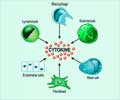A light-triggered cancer treatment called photodynamic therapy (PDT) may be able to treat advanced cancer at the same time as targeting local tumours, according to research published in the British Journal of Cancer today (Tuesday).
PDT is a relatively new way of treating cancer, still at an early stage of development and being researched in labs around the world. It uses drugs that are usually harmless but become highly effective at killing cancer cells when exposed to light. Shining light on a tumour after one of these drugs has been injected selectively activates the drug in that area, treating the cancer but avoiding some of the side effects associated with chemotherapy.Researchers from the Roswell Park Cancer Institute in the US have now shown that one particular form of PDT might have the potential to do more than treat local tumours. In early studies using animal models, they found that treatment with PDT stimulated the immune system to move out and attack cancer cells elsewhere in the body.
Their research raises the prospect of using local PDT to treat cancer that has spread. Dr Sandra Gollnick, senior author of the research, explains: "We took laboratory models with tumours in the shoulder and lungs. This was to simulate advanced cancer that may start somewhere locally, like the shoulder, and spread to the lungs.
"Solely treating the tumours in the shoulder worked as normal for PDT. But it also sparked off an immune response that reduced the number of tumours in the lungs as well. We made sure this wasn't due to activated drug reaching the lung tumours, and we were able to identify the precise part of the immune system being activated.
"It's the first time this effect has been seen and explained in such detail, although other scientists have predicted that PDT could trigger an immune response."
Dr Lesley Walker, director of cancer information at Cancer Research UK, which owns the British Journal of Cancer, said: "These early results were obtained using a specific line of cancer cells and using one particular type of PDT.
Advertisement
Source-Cancer Research UK
LIN/S











